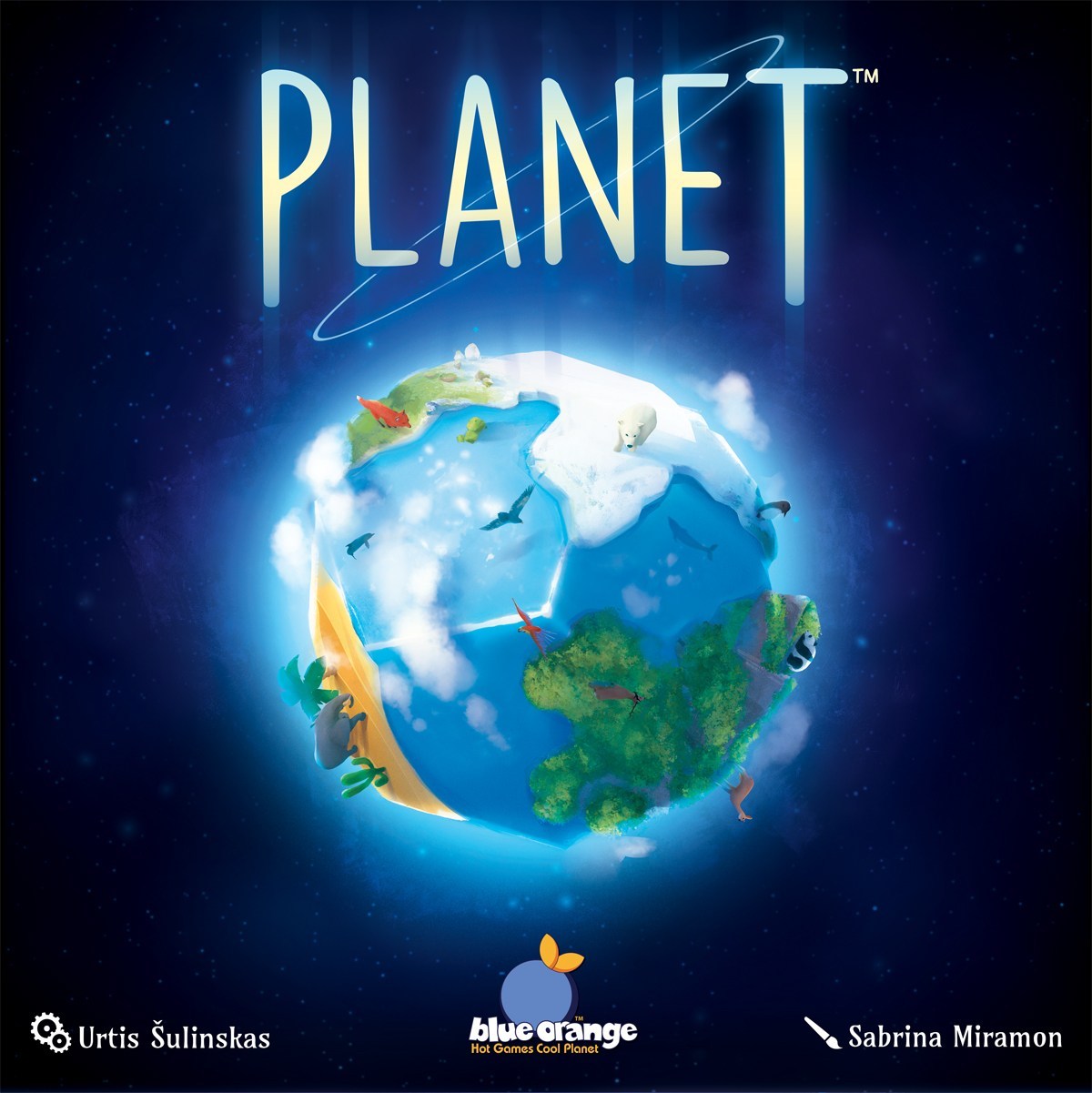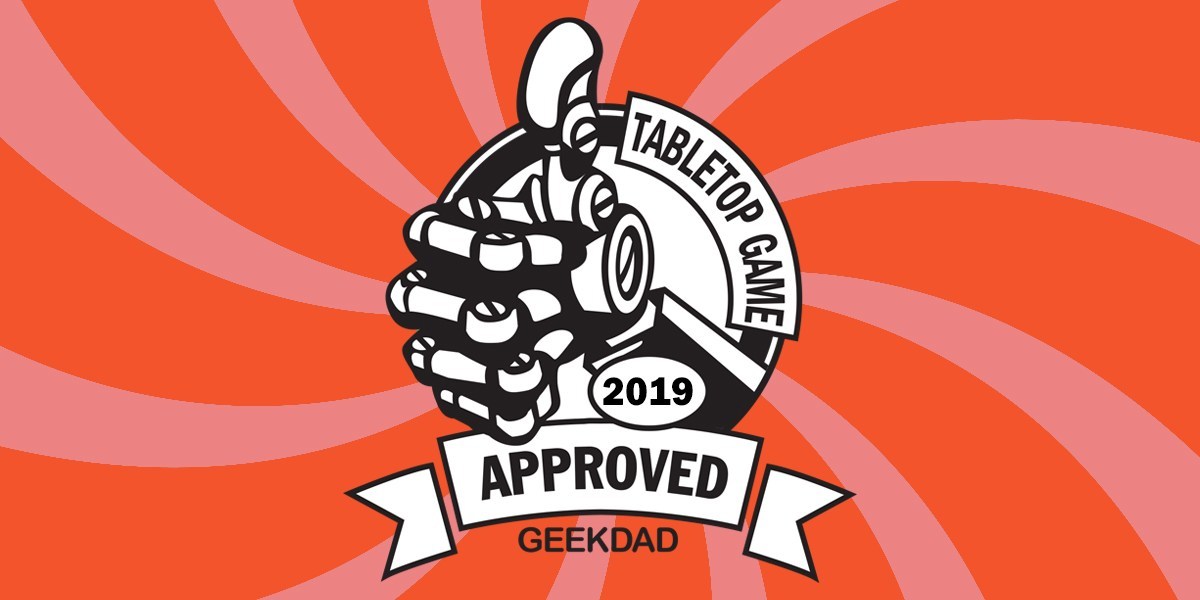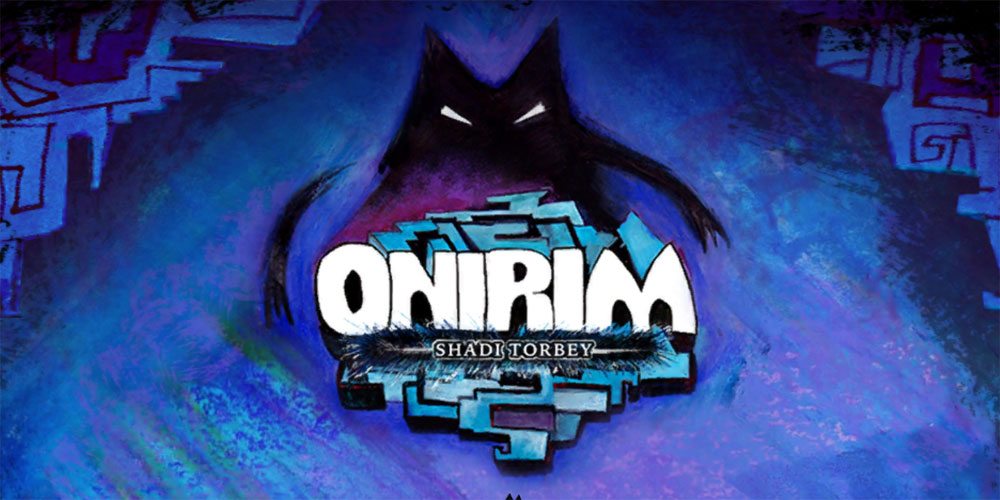Assemble your planet, arranging mountains, deserts, forests, water, and ice, to create ideal habitats for animal life to flourish!
What Is Planet?
Planet is a tile-placement game with a unique twist, designed by Urtis Šulinskas, for 2 to 4 players, ages 8 and up, and takes about 30–45 minutes to play. It will release on Earth Day (April 22) next week, with a retail price of $39.99. You can pre-order it now from Blue Orange Games, or look for it in stores soon. The game is family-friendly both in gameplay and theme, and gives a definite advantage to those who excel in spatial reasoning.

Planet Components
Here’s what comes in the game:
- 4 Planet cores
- 50 Continent tiles
- 45 Animal cards
- 5 Natural Habitat Objective cards
- First Player token

The star of this game is definitely the planet cores: they’re large plastic dodecahedrons (think 12-sided dice), with circular metal plates stuck to each face, and a slight lip around the edges. The continent tiles are pentagons—cardboard with five terrain triangles on the top, and a magnetic face on the back. These combine very easily to create a round-ish planet as you play the game: the lips keep the tiles from sliding around, and the magnets usually stick pretty well to the metal plates (though if you’re tossing or rolling the planets around, a sharp impact can knock tiles off). There are a couple of spare metal plates provided, in case any come off—but be warned: they’re very sticky on the backs.

The game is very tactile, as you’re constantly turning your planet over in your hand, looking at how the terrain is arranged and looking to see where you might add your next tile. The planets seem very large when you first see them, but any smaller and the tiles would be more difficult to handle. They’re definitely a lot of fun to play with. Yes, they’re sort of a gimmick, but it’s a good gimmick, and is well integrated with the game play.
The animal cards are pretty simple: an animal along with a couple of icons that indicate what type of habitat it prefers. Each card has a colored border that matches its preferred terrain type, which is also used in scoring. I actually thought the animals on the cards were photographs at first, but they’re actually illustrations by Sabrina Miramon. The natural habitat objective cards each show a particular type of terrain (with a matching colored border). The numbers in the triangles are a little small so they can be a little difficult to read, but otherwise the card quality is fine.

How to Play Planet
The Goal
The goal of the game is to score the most points in 12 rounds by acquiring animal cards and fulfilling your habitat objective.

Setup
Shuffle the tiles and make face-down stacks of 5 tiles, set in a row—these tiles will be used for the first 10 rounds, and discarded tiles will be used to make up the last two rounds. Shuffle the animal cards and create face-up rows of animals next to the stacks of tiles:
- Rounds 1–2: 0 cards
- Rounds 3–5: 1 card each
- Rounds 6–9: 2 cards each
- Rounds 10–12: 3 cards each
Place the rest of the animal cards back in the box.
Shuffle the natural habitat objective cards and deal one to each player face-down. Each player may look at their own card, but these are kept secret until the end of the game.
Give each player a planet core. Choose a starting player (the manual suggests the youngest player) and give them the first player token.

Gameplay
Each round, flip over the stack of tiles and reveal them. In turn order, each player takes one tile and attaches it to their planet core. You may place the tile on any empty space—it doesn’t have to be next to another tile, and terrain types do not have to line up when you place them (though there’s often an advantage to do so). After everyone has taken one tile, any remaining tiles are discarded face-down to form the stacks for rounds 11 and 12 until there are two stacks of 5 tiles each—after that, any additional remainders are just discarded from the game.

Starting in round 3, after everyone has taken and placed a tile, then you award the animal cards. Each animal card has an icon showing what criteria to evaluate. Most cards show two pentagons: the large pentagon indicates the primary terrain type, and the small pentagon shows a secondary terrain type, with or without a red “X” on it. The card is given to the player who has the largest contiguous region of the primary terrain type—but it must touch the secondary terrain type if there is no “X,” or not touch the secondary terrain type if there is an “X.” If there’s a tie, then the tied players look to see who has the second-largest region fitting the criteria, and so on.

Animal cards with five pentagons on them are awarded to the player who has the most disconnected regions of that terrain type, regardless of the size of each of those regions. For instance, to win the whale card, you must have more separate ocean regions on your planet than any other player. (There are only five of these cards in the deck, one for each terrain type.)
If there are ties that cannot be broken (or ties for the most disconnected regions), then the card is moved to the next round.
After each round, pass the first player token clockwise.

Game End
The game ends after round 12, when everyone’s planet is completely filled and all of the animal cards have been awarded. (Or discarded, if there’s still a tie in the last round.)
Reveal your natural habitat objective card. Each animal card that is the same terrain type as your objective is worth 1 point. Each animal card that is a different terrain type than your objective is worth 2 points.
Finally, you count up how many triangles of your objective terrain are on your entire planet. (It’s usually easier to do this by removing all the tiles from the planet.) Compare your total to see which threshold you reached—you get the number of points shown below that triangle.
The player with the highest score wins! In case of a tie, the player with the most animal cards wins.
Variant Rules
For a beginner game, play without the natural habitat cards, and each animal is worth 1 point.
For the “mystery animals” variant, set up as before, but in rounds 2 through 12 each round has one face-up animal card and one face-down animal card. You reveal the first face-down animal card (next to the round 3 stack) in the first round, and then reveal the next one in the next round, and so on, so that each animal card is revealed 3 turns ahead.
Planet is GeekDad Approved!
Why You Should Play Planet
Planet reminds me a little bit of Kingdomino, in the way that players are drafting tiles and arranging them to meet certain criteria for scoring, except that everything is in 3D. Okay, there are some significant rules differences, too, but it has that similar feel of filling out a region with tiles and trying to figure out the best way to make everything fit just so. Playing in three dimensions, however, leads to some interesting abilities and restrictions. For one, you can’t see your entire planet at once, so you have to turn it around and look at it from different angles. The other, of course, is that tiles wrap around, so sometimes you end up with terrains adjacent to each other that you hadn’t intended, simply because you’ve gone all the way around your planet already.
It’s fun just picking tiles and sticking them on your planet—and of course we have silly conversations about which planet must be Tatooine or Hoth based on the predominant terrain types—but once everyone starts thinking about those animal cards, competition can become pretty intense. If you really want that penguin, you start asking everyone how large their ice regions are, and that may affect which tile you take or where you place it. If you can tie with the leader, then maybe you can delay things long enough for you to get ahead!
Planning ahead can be very important. Since all of the animal cards are laid out at setup, you can look ahead to see what terrain types you’ll need later. If there are a lot of yellow cards, it might be worth investing in desert tiles even if that’s not your objective, because you could score a lot from those animals. Sometimes the order of the cards makes it difficult to claim certain combinations. For instance, if the badger (forest not touching desert) comes in an earlier round than the tiger (forest touching desert), then you can create a large forest not touching desert, and then attach a desert later, and potentially claim both animals. But if they were reversed, your tiger-winning forest is ineligible for the badger, so you’d have to create two large forests to win both cards.

Scoring is really simple, because each animal is just worth 1 or 2 points. I like the way they’re scored, though new players are often a little confused when I first tell them the scoring values. If your objective is to build an ice planet, then you’re going to have a natural advantage in getting ice-based animals, so they’re not worth as much. But if you manage to get mountain-based animals on your ice planet, then those are worth more points. That sets up a nice tension between always drafting tiles that match your objective and drafting tiles that will gain you more animals—I’ve seen winning scores from both approaches, so there’s no guarantee that fulfilling your objective is always the right tactic.
Hate-drafting is also possible (for those of you who enjoy that): if you know somebody is really eager to get a particular animal, or you’ve guessed what their secret objective card is, you can take tiles that you know they want, simply to prevent them from getting them. Of course, that’s only really helpful if you can still score some points from those tiles, too.
The “mystery animal” variant is good for those who have a lot of trouble planning ahead and would benefit from a little more random chance (or just a little less information to process). It does shift the balance from skill to luck a little more, but can also make the game a little more accessible. But if everyone at the table is comfortable with seeing everything at once, I usually prefer that mode.
I recently took Planet to GameStorm, a local gaming convention, and it was one of my top-requested games that weekend. Some people had heard of it and were excited to try it, and others were just drawn in when they walked by a game in progress. The planets and magnetic tiles are definitely eye-catching, and because the game is easy to learn, it attracted both casual and hardcore gamers to the table. As with many tile-laying games, it’s satisfying to reach the end of the game and look at what you’ve created—but with Planet, it’s a physical object you can hold and admire … at least until you peel all the tiles off so you can calculate your score!
Planet adds another dimension (literally!) to tile-laying games, so if you enjoy that genre, it’s definitely worth checking out. For more information, visit the Blue Orange Games website.
Click here to see all our tabletop game reviews.
![]() To subscribe to GeekDad’s tabletop gaming coverage, please copy this link and add it to your RSS reader.
To subscribe to GeekDad’s tabletop gaming coverage, please copy this link and add it to your RSS reader.
Disclosure: GeekDad received a copy of this game for review purposes.







